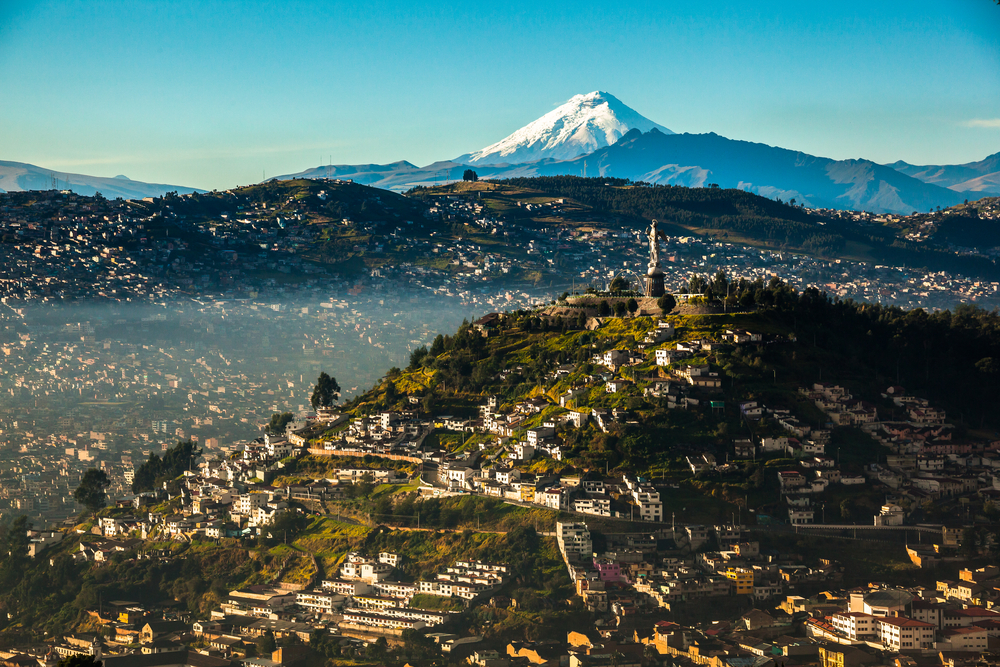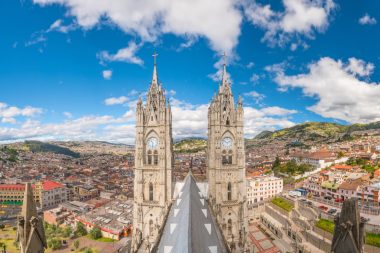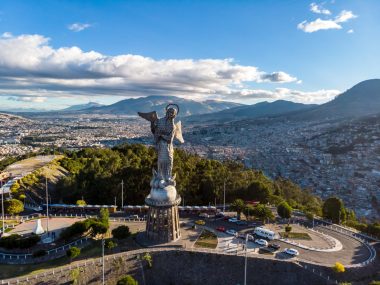
If you are looking for the equator on the globe, you will find it in Ecuador, among other places. This country lives up to its name, because it is something like the belt of the planet or the seam of the earth. In Ecuador, it is customary to mark houses and wells along the paths wherever you identify with the “zero line”. This is not possible in Quito, the capital of Ecuador, because the Andean metropolis is almost exactly 25 kilometers south of the equator. Up to an altitude of 2,850 meters, the urban area stretches at the foot of the active volcano Pichinga, and since Quito Airport is surrounded by other mountains, landing poses a certain challenge for the pilots. But one thing is certain: this fascinating city is worth a trip, and when the rain clouds clear over Quito, planes land there safely and every minute.
“Centro Histórico” – the colonial past
Colourful and mixed together – this is how the sea of houses in this city of millions appears. But the colonial center of Quito is an exception, because the approximately three hundred houses were already ennobled by UNESCO in 1978 and included in the list of World Heritage Sites by this organization. “Pearl of the Continent” is what the inhabitants of Quito call their historic gem. Half a century ago, when the old town was in danger of falling into disrepair, the authorities intervened and were successful in their efforts to restore the old glory of these buildings and preserve them for future generations. The original market halls were activated and a number of restaurants and hotels were built. The “Centro Histórico” is unique on the South American continent. With no less than forty churches and 16 monasteries.
The resting place of the national hero de Sucre

Quito has undoubtedly benefited from her prescribed beauty treatment. The old city was allowed to sip from the sources of this “Gesundbrunnen” and Quita has now tamed its architectural confusion. The multitude of Baroque churches impresses every visitor and they are places of refuge for the devout inhabitants who feel they belong to the Catholic churches. Originally, the cathedral of Quito was a simple mud building, which only gradually recovered from the severe earthquake that reduced this city to rubble in 1755. In “La Catedral” rest the mortal remains of the national hero Antonio José de Sucre, who defeated the Spanish troops in the Battle of Pichincha and was later elected president of the newly founded state of Bolivia .
The “Winged Virgin” in the convent
Quito owes the Iglesia y Convento de San Francisco to a Franciscan, who was not only a pious monk but also a brilliant architect and artist. The Flemish founder of the convent, Fray Jodoco Rike, created an architectural marvel in the second half of the 16th century. San Francisco is the oldest and probably the largest church from the colonial past of the city of Quito. Among other things, the Mudéjar wooden ceiling, which was built in the Spanish-Moorish style and adorns the central nave of the convent, is impressive. The fact that Quito was a cosmopolitan city in the 17th century is proven by the Chinese pagodas in the church. However, a much-noticed motif is also the so-called “Winged Virgin”. They are only available here in the world.
The “Virgen del Panecillo” watches over Quito

In view of the deep faith of the people who live in Quito, it is not surprising that the churches determine the image of the metropolis. At Plaza San Francisco , the Jesuit church La Compania is not only the oldest Christian church in America, but also an impressive example of the colonial aesthetics imported from Spain. Numerous churches in Quito were built of volcanic rock and refer to the neighbourhood of the Fire Mountains. The “Virgen el Panecillo” watches over the confusing sea of houses of the city on one of the hills. The Incas gave this elevation the name “Heart Hill”, but the people of Quito thought it had more of the appearance of a bun. And so they called the monument made of aluminum in the shape of a Madonna “Virgin of the Bun”.
Museums in the “City of Eternal Spring”
If you take the trouble to hike to the foot of the 45-metre-high Madonna statue, you can discover the snow-capped summit of the distant Cotopaxi volcano from there – in ideal weather conditions. But if you prefer to stay in Quito, you should not miss a visit to three museums. The Casa del Alabado promises an interesting walk through the history and pre-Columbian art of Ecuador. Unique exhibits from earlier advanced civilizations are stored on several floors. In contrast, the Museo Casa de Sucre sees itself as a kind of ancestral gallery. Here, the former residence of the general was built in a condition true to the original. The National Museum was housed in a gigantic building made of mirrored glass. The collections of archaeological finds there are impressive. Among other things, the two-thousand-year-old gold mask of the sun god Dios-Sol from the La Tolita culture can be seen. The temperatures in Quito are pleasant, and the mild climate gave the Ecuadorian metropolis the pretty nickname “City of Eternal Spring”.

